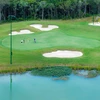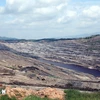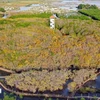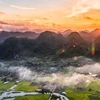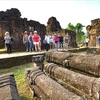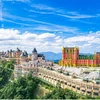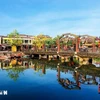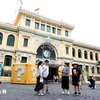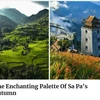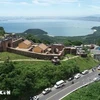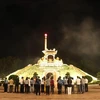Ba Vi National Park is the nearest "green world" to the capital city of Hanoi, where nature-lovers can find an ideal escape from the hustle and bustle of city life in all four seasons.
In spring, the forest is highlighted with striking colours of wild peach blossoms and apricot flowers, while in summer the dense forest is dryer and brighter with light sunshine beaming down through thick layers of leaves. Autumn covers most of the trees with yellow coats and winter seems to bring a fresh cool air to the space.
Located in the middle of the northern plain, Ba Vi (Three Peaks) is mentioned in the ancient legend of the Mountain God Tan Vien, and is said to be his final resting place.
The highest peak, known as King Peak, is 1,296m, followed by Tan Vien Peak (Mountain God) at 1,227m and Ngoc Hoa Peak at 1,131m. There is a temple dedicated to President Ho Chi Minh on King Peak and another to worship the Mountain God on Tan Vien Peak.
At the entrance to the park is Tien Sa Tourism Site, where a 20ha lake is surrounded by a 120ha forest.
The site is divided into several themed zones to suit various ages, including a water park of 3,000sq.m with three swimming pools and nine slides and a games area of 2,500sq.m.
Young people can enjoy boating or play tennis, football, volleyball and badminton.
Following the sloping zigzagging 12km road from the park gate, visitors will have a chance to see the rich local flora and fauna. The park is home to more than 1,200 kinds of plants, 21 of which are mentioned in Vietnam 's Red Book of rare and threatened species. There are also 63 species of animals.
Some old vestiges of the French occupation have recently been opened to the public at 1,000m above sea level thanks to the upgraded road leading to the ruins.
According to a French document dating back to the 1930s, the French planned to build three resorts at heights of 400, 600 and 1,000m above sea level, and were particularly keen on developing the highest one. Between 1932 and 1944, they built various facilities like a hostel, playground, church, orphanage and military basement which can still be seen today.
A jail was also built in the 1930s capable of holding up to 200 prisoners, and some of the implements used to torture the prisoners are now on display.
A new trekking route has been opened leading up to some of the parks oldest trees, mostly Bach Xanh (calocedrus macrolepis). Hundreds of them flourish at an altitude of 1,000m, and the tree offers fine wood with a gentle fragrance which is easily processed into furniture and houses.
At the end of the road, climbing over 1,000 steps leading to the temples on King Peak or Tan Vien Peak is another unforgettable experience.
From King Peak, the scenery looks like a huge painting with giant "strokes" of green grass fields, yellow rice crops and the Da River zigzagging through the undulating hills.-VNA
